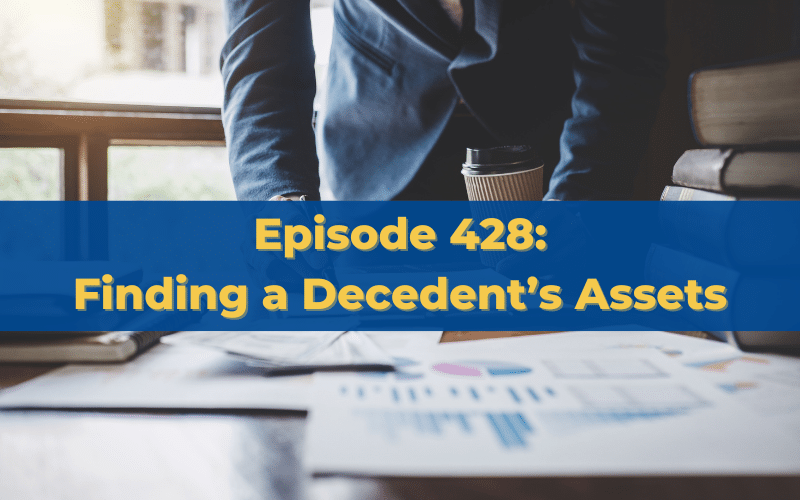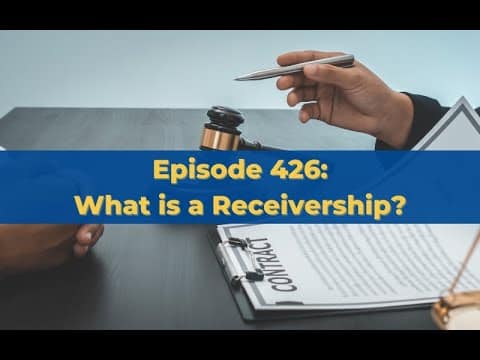Podcast: Play in new window | Download | Embed
Subscribe Apple Podcasts | RSS | Subscribe:
When an individual passes away, it falls to those left behind to determine what happens with any property and assets that individual possessed during their lifetime. The process of finding all the property and assets can be extremely complex, depending on what the property is and where it is kept. It’s relatively simple to find things like a house and a car, as those are large, tangible items. But in many cases, a person’s wealth that may be passed to beneficiaries and heirs can be difficult to locate, especially if the assets are intangible items such as investment accounts and partnership interest. Often, the breadth and nature of an individual’s property and assets hasn’t been communicated to any loved ones. This makes it far more difficult to locate some of the following assets:
- Bank accounts
- Brokerage accounts
- Property titles
- Insurance policies
- Interest holdings in partnerships or corporations
Records of these assets, and the ability to access them, are necessary to complete probate and ensure all heirs and beneficiaries receive their share.
Who is Authorized to Access a Decedent’s Assets?
Although family members may perform a basic database search following the estate owner’s death, they will find it difficult to get information about, let alone access to certain things like retirement or bank accounts. If the decedent planned ahead, they may have named a third-party to be able to ask questions or access the account in the event of an emergency or their death. But if no other party has been given the authority to access that information, most financial institutions will require letters testamentary or court orders to release information. Often it falls to the estate’s executor to access those assets. Also termed an administrator, executors are empowered either by the decedent or by the courts to manage the decedent’s affairs following death.
A probate case concerning the estate will need to be opened before an administrator – independent or dependent – can start accessing assets.
An independent administrator is named in the decedent’s will and has broad powers in discovering and managing a decedent’s assets. A dependent administrator is designated by the court if no one is specified in the will. Dependent administrators are limited in comparison to independent executors and must receive court authorization before they can access or make any decisions regarding the estate’s assets.
Leaving Assets Behind? Create and Leave a Will
If you know you’ll be leaving behind considerable wealth, invest a small amount of time into creating a will. Though it is fairly simple to create one, it is recommended to have an estate planning attorney help with this. (We are currently working with a client where the decedent used a software program to create her will, and there are lots of problems with it that have caused the client to hire our firm to resolve.) Once you have created your will, put it in a place where loved ones can easily find it. Make sure an executor has been named. Your will should also include a general summary of the estate’s assets and where they can be found. This information will be valuable when it’s time for your executor to gather property for probate.
Where Can an Executor Search for a Decedent’s Assets?
If no estate planning documents are available to provide an inventory and location of assets, the only option is to begin a thorough search that may include the following:
- Searching the decedent’s home for documentation – The first step in every asset search is surveying the decedent’s home for any helpful documentation. This could be a will, but it could also be property titles, account passwords, contact information for an attorney or CPA, or anything else that could be helpful in guiding the executor. If important paperwork is at the decedent’s home, it may be located in a filing cabinet, a safe, a lockbox, or another secured container. If you are lucky, the decedent will have everything specified in the documents they leave behind. If not, you’ll need to dig deeper.
- Searching the decedent’s phone or computer for information records – If a home search doesn’t turn up any critical paperwork, an independent administrator (or authorized dependent administrator) can search the decedent’s phone and computer for information. Chances are, these devices will be secured, but administrators may hire a computer forensics expert to crack through the device’s security and search for passwords, account information and the like. Authorized administrators are allowed to hire anyone they deem necessary to access the decedent’s assets.
- Contacting financial institutions and working with them to access accounts – Regarding bank, brokerage and retirement accounts, the first step is locating them. This can be a major challenge itself, and it may only be the beginning. Once the decedent’s accounts have been identified, the administrator will need to open up communication with the relevant banks or financial institutions. The mission here is to convince the institution to provide account information, but this rarely comes easy. The manager in charge of the decedent’s account likely won’t have the authority to provide this information. Further, banks almost always deny account information requests unless compelled to do so.
- Seeking court orders to authorize access or compel a third party to cooperate – When access-related roadblocks do emerge, and they will, administrators will need to get the courts involved. In most cases, financial institutions will provide the desired information if they receive a court order, but it must include the right provisions. If financial institutions are particularly stubborn, they can be compelled to respond to a court summons and explain their reasoning. In the majority of instances, it won’t come to this.
- Locating the decedent’s accountant, attorney or insurance agent – The decedent’s accountant, attorney and insurance agent can provide extremely valuable insight into the decedent’s assets, where they may be located, and whether the estate is involved in any judgments. You can track down essential financial documentation such as tax returns as well.
Searching for a Decedent’s Assets? Consult with an Experienced Estate Planning Attorney
If you’ve stepped into an administrator role and are responsible for tracking down a decedent’s assets, it can be overwhelming. Our firm has assisted many administrators in this process, and it typically requires detailed, creative thinking to complete. If you’re an estate’s administrator or a potential heir, and you’re not sure what the next steps are, our expert team of CPAs and attorneys can offer solutions and expedite the process of finding a decedent’s assets.


